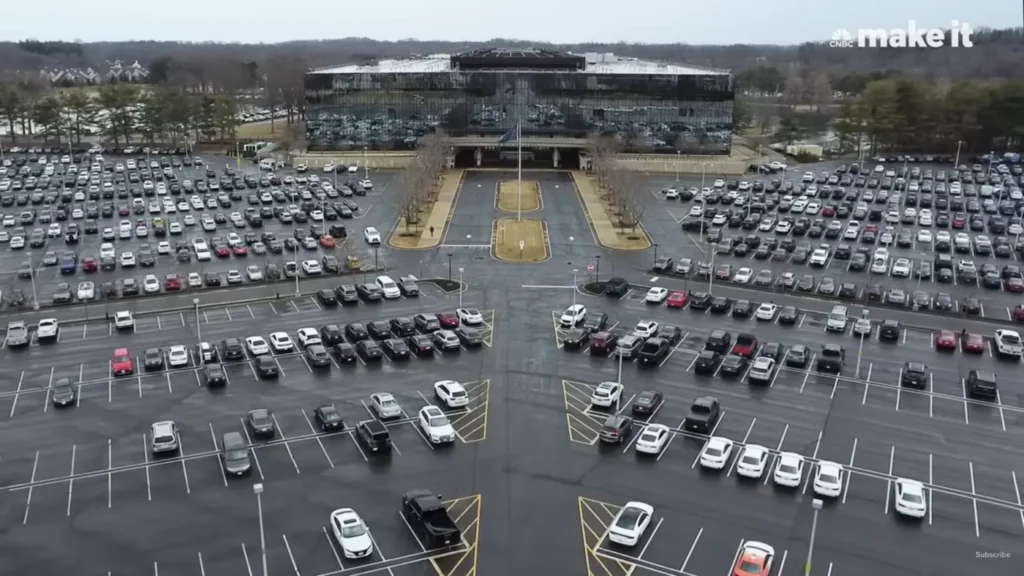The Lumon Building Is Real — and Has a Surprising Story
The Lumon building in Severance is more than just a striking set.
In real life, it was sold for 27 million dollars and carries a story that mirrors the very themes explored in the series.
Known as Bell Works, the building was originally the headquarters of Bell Labs. Today, it functions as a modern and vibrant space. Yet for a few days, this lively environment was transformed into the cold and impersonal headquarters of Lumon Industries — a symbolic conversion that speaks volumes about the show’s critique of control.

From Bell Labs to Bell Works: The Birth of the Building
Long before it debuted as Lumon’s headquarters, the building we now know as Bell Works had a very different purpose.
In the 1950s, the telecom giant Bell Labs set out to build a research center that would bring together its top talent. To do so, they hired Eero Saarinen, one of the most important names in modern architecture — known for works like the TWA Flight Center and the Gateway Arch.

The result was a building marked by the core features of brutalist architecture: raw concrete, sharp angles, and monumental proportions that leave a strong impression.
Despite its austere appearance, the space was designed to promote innovation and collaboration. Scientists, engineers, and technicians shared not only the hallways but also their lives outside of work. The campus even offered a farmer’s market, daycare, and a rare sense of community for a corporate setting.

Bell Labs in the early years: a research center designed to drive innovation and community life.
A Silent Colossus Awaiting Renewal
For decades, the building hosted research and inventions that shaped the communications era. Over time, however, technological progress and changes in the industry emptied the space.
By the time Alcatel-Lucent decided to sell it, the building was nearly deserted — a silent colossus surrounded by memories.
It was in this context that Ralph Zucker, president of Inspired by Somerset Development, saw potential where most people saw abandonment. That’s when the building began its second life — with a new name, a new purpose, and eventually, an unexpected role: the cold heart of Lumon in Severance.

Ralph Zucker, president of Inspired by Somerset Development

With the building practically empty, all that remained was the monumental architecture and memories of an innovative past.
The Rebirth: How the Building Was Bought and Restored
When Ralph Zucker walked into the old Bell Labs building, he found a space that was empty and lifeless. Nothing reminded him of the innovation hub it once was. Still, he saw a rare opportunity: to transform that abandoned place into a new urban center.

The idea was bold. Instead of tearing down or replacing the structure, Zucker decided to adapt it. His plan was to preserve the brutalist architecture, while completely redefining its function. That’s how the concept of a metroburb was born — a miniature city inside a single building.
Bell Works: From Ruins to Reconstruction

Buying the building was just the beginning. For the project to move forward, Zucker had to negotiate with local authorities, regulatory bodies, and a variety of stakeholders. In total, it took five years of effort before the transformation truly began.
The renovation unfolded in clearly defined stages. First, teams cleaned and revitalized the main floors. Then they adapted the interiors to host businesses, events, and social spaces. Over time, office rooms, cafés, a library, children’s areas, and cultural venues began to emerge. Bell Works grew into a complete experience, aiming to create a vibrant and dynamic community inside the building.

Bell Labs at a community event in the evening.
A New Vision of Community
More than just a business center, Bell Works became a creative and collaborative hub. The idea behind the project was simple yet powerful: to create a space where people could work, meet, learn, and relax — all under one roof.
This vision, however, directly contrasts with the version shown in Severance. In the show, the building stands for isolation, surveillance, and emotional detachment. In real life, it became a symbol of collective reinvention — and perhaps the perfect metaphor for what the series aims to critique.
The Lumon Building in Severance
It was during the renovation of Bell Works that the Severance production team discovered the location. What drew their attention wasn’t just the brutalist architecture, but the contrast between the building’s cold lines and the human-centered purpose it was starting to reclaim.
According to Ralph Zucker, the team’s visit was striking. Seeing Bell Works transformed into Lumon’s headquarters left him feeling both fascinated and unsettled:
“It literally made my heart skip a beat. I had to remember that this was temporary. This was just the movies, and it would be over within a few weeks.”
During filming, the interior spaces were redesigned with neutral tones, artificial lighting, and impersonal partitions — reinforcing the claustrophobic feeling that defines the work life at Lumon. Still, something remained: the monumental scale and architectural weight of the building fit perfectly into the world of the series.
A Symbolic Choice

Jeremy Hindle, production designer for Rupture, discusses the parallels between Bell Works and Lumon.
Jeremy Hindle, production designer of Severance, reflected on the parallels between Bell Works and Lumon.
Choosing to film in a real location — one with a history of science and innovation — added depth to the series’ narrative. The building leased to portray Lumon had once been a center for collaboration, later fell into abandonment, and in fiction became the home of a company that manipulates memories and erases identities.
As Hindle put it:
“It’s like Lumon’s sort of the same. Just took the wrong path.”
His observation invites us to reflect on the role of architecture in storytelling.
In Severance, physical spaces aren’t just backdrops — they’re visual extensions of the characters’ psychological split.
Repetitive corridors, the absence of windows, and the monumental scale all contribute to a constant sense of fragmentation, erasure, and surveillance.
A Contrast Between Fiction and Reality
In Severance, Lumon’s building is a sealed environment, defined by windowless hallways, artificial lighting, and strict rules. Everything about it conveys control, monitoring, and emotional isolation. In real life, though, the same building sends a completely different message.
Today, Bell Works is full of life. There are cafés with outdoor seating, art and design events, coworking areas, and play spaces for children. People chat in the halls, visit the library, and take part in local fairs — all within the same place that briefly became the set for one of the most dystopian offices on television.
The Same Space, Two Worlds
What makes this contrast so powerful is that nothing had to be digitally recreated. The series repurposed a real space with an enigmatic and monumental design to tell a story about identity fragmentation.
And as Ralph Zucker pointed out:
“You don’t need to sever somebody’s brain to get them back into the office.”
For him, Bell Works represents the opposite of Lumon: an invitation to connection, creativity, and building community.
More Than a Set: A Force of Transformation
This duality — between what the building represents in fiction and what it became in reality — reveals something essential about the power of architecture. Spaces aren’t neutral. They influence behavior, inspire ideas — or limit possibilities.
In Bell Works’ case, the show used it as a metaphor for alienation. But beyond the screen, it became a real-world example of meaningful urban revitalization.
Conclusion
The Lumon building in Severance is a silent character in the show — and now, also a real example of transformation. From innovation hub to abandoned shell, and then into a thriving urban core, Bell Works proves that a single environment can be interpreted in radically different ways.
In fiction, it stands for corporate control and identity loss. In real life, it represents reconnection, creativity, and renewal.
This overlap between imagined and real worlds is one of Severance‘s greatest strengths. And understanding the story behind the building that visually grounds the series helps us realize how every detail carries more meaning than it first appears.
Want to dive deeper into the themes and secrets behind the series?
Explore our full Severance section:
Click here!
Posts Recomendados
Carregando recomendações...




